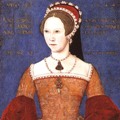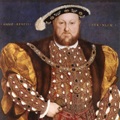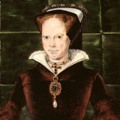Day in History: Mary I becomes Queen Regnant of England
On July 19, 1553 Mary Tudor replaced Lady Jane Grey on the English Throne, becoming the first undisputed Queen Regnant of England.
Mary was born on 18 February 1516 to Henry VIII and Catherine of Aragon. She was a much loved child and, because she was their only surviving one, was doting upon by her parents. Once it became apparent Queen Catherine would not have more children, Mary was treated as Heiress to the Throne; although she never formally held the title, she was nevertheless occasionally referred to as “The Princess of Wales”; she certainly enjoyed all privileges of an Heir.
Lady Mary’s happy childhood came to an abrupt end with her parents’ divorce. After Henry VIII’s remarriage and birth of Princess Elizabeth, Mary was removed from the Line of Succession and Elizabeth was declared to be the new Heir. Mary was forced to join her half-sister’s household as her lady-in-waiting. During the time, she was not allowed to meet her mother, and very rarely encountered her father. Things changed for better when Henry VIII married Lady Jane Seymour; Jane was kind to Mary and helped her mend relationships with her father. In turn, Mary did not dispute her father’s third marriage since Catherine of Aragon was already dead at the time. When Jane Seymour was dying of post-natal complications after giving birth to Henry VIII’s only legitimate son, she asked Mary to become godmother of her son, Edward.
Henry VIII was very pre-occupied with succession; to ensure it, he made the Parliament accept Third Succession Act. According to it, Henry was to be succeeded by Prince Edward (future Edward VI). If Edward died without legitimate heirs, he would be succeeded by Mary (future Mary I), then Elizabeth (future Elizabeth I). If all three died without issue, the Throne would go to the descendants of Henry VIII’s younger sister, Mary, Queen of France. The descendants of Henry VIII’s elder sister, Margaret Tudor, were excluded because Margaret had married into Scottish Royal Family; Henry was not keen to unite the two Crowns. Things didn’t go quite as planned, however; when Mary’s half-brother, Edward VI, died from what is believed to be tuberculosis at the age of 15, his successor was supposed to be his half-sister, Princess Mary in accordance with the aforementioned Act. However, Edward was reluctant to let Mary succeed him because he feared that Mary, a devout Catholic, might try to restore Catholicism in England. To avert that, he excluded Mary and his other half-sister, Elizabeth, from the Line of Succession and instead named his cousin, Jane Grey (a great-granddaughter of Henry VII), as his successor.
The decision was neither a popular, nor a legal one since the previous succession line was established by the Parliament, and a mere will could not overwrite that; Edward would have needed another Act to overrule it. Jane was proclaimed Queen on 10 July 1553, and Mary took immediate actions; she assembled a military force at Suffolk and secured loyalty of the people, the army and most of nobility. Jane was deposed and imprisoned in the Tower on July 19 – the day that is considered the first official day in Mary I’s reign.
The new Queen triumphantly rode into London, accompanied by her half-sister, Elizabeth, over 800 nobles and gentry, and a huge crowd of well-wishers. Although Mary left an unfortunate legacy, eventually coming to be known as “Bloody Mary”, she was initially immensely popular in England. Many felt sympathy and affection for Lady Mary who had to endure years of sorrow in her father’s hands and was not even allowed to meet her dying mother. Unfortunately, the goodwill didn’t last long. Mary’s over-zealous pro-Catholic feelings alienated most people because by the time, England was already a largely protestant country. Perhaps even more damaging was her choice of husband. The new Queen decided to marry her cousin, Philip of Spain (future Philip II) – a fellow devout Catholic.
At the time, under the English common doctrine of jure uxoris, the properties and titles belonging to a woman became her husband’s upon marriage. That meant, in essence, that any man Mary would choose to marry would become King of England in fact and name. There was no precedence of joint reign in England at the point, although Queen Mary’s maternal grandparents, Ferdinand of Aragon and Isabella of Castile, were joint rulers of Spain.
The marriage treaty was thus very carefully drafted; under the terms, Philip did become King Regnant of England (and was styled accordingly “King Philip of England”) – but only for the duration of Mary’s reign. All official documents were dated with both their names, the Parliament was called under the joint authority of the couple; at the same time, Philip could not act in England or in England’s name without Mary’s consent, had no succession rights. One of the most important points of the treaty was the assurance that England would not be obliged to provide military assistance for any wars Philip waged. All those plans eventually proved futile, however, as Mary – deeply enamoured by her husband – was a pawn in his hands. She also agreed to support Philip’s war against France, which resulted in England losing its only land on the continent – Calais.
Mary’s sad and brief reign came to an end with her death on 17 November 1558, less than five years after her accession to the Throne. She was succeeded by her half-sister, Elizabeth, who reigned for nearly 50 years and orchestrated England’s Golden Age. Nevertheless, Mary holds an important place in English history as its first female ruler. Of course, there had been Queens Regnant in the British Isles before, including Margaret, Maid of Norway (Queen of Scots from 1286 to 1290) and the famous Boudicca, Queen of the British Iceni tribe. In fact, there had been Queens Regnant in England before as well – Empress Matilda (the heiress of Henry I), and Lady Jane Grey who briefly succeeded Edward VI. However, the reigns of Empress Matilda and Jane Grey are disputed and they are not generally considered to have been “proper” Monarchs. Mary’s reign was a novelty; while it was neither long, nor particularly successful, it still proved women could ruled as effectively as men, and perhaps even more ruthlessly.
Filed under Historical Royals, The United KingdomTagged Edward VI of England, Elizabeth I of England, Henry VIII of England, Lady Jane Grey, Mary I of England, Philip II of Spain, Succession.












Leave a Reply